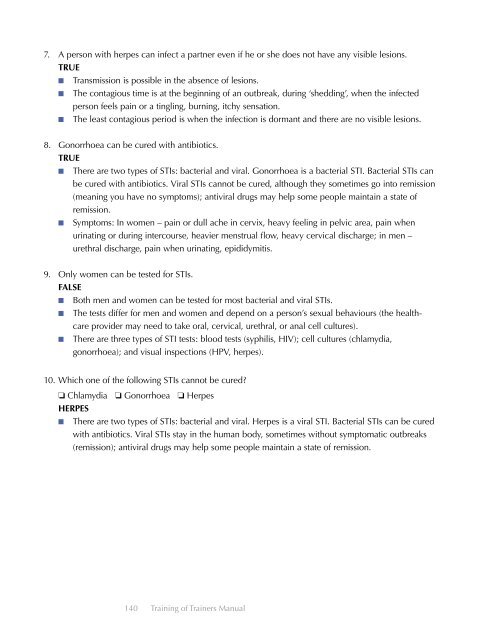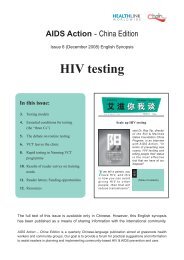The Training of Trainers Manual - UNFPA
The Training of Trainers Manual - UNFPA
The Training of Trainers Manual - UNFPA
Create successful ePaper yourself
Turn your PDF publications into a flip-book with our unique Google optimized e-Paper software.
7. A person with herpes can infect a partner even if he or she does not have any visible lesions.<br />
TRUE<br />
■ Transmission is possible in the absence <strong>of</strong> lesions.<br />
■ <strong>The</strong> contagious time is at the beginning <strong>of</strong> an outbreak, during ‘shedding’, when the infected<br />
person feels pain or a tingling, burning, itchy sensation.<br />
■ <strong>The</strong> least contagious period is when the infection is dormant and there are no visible lesions.<br />
8. Gonorrhoea can be cured with antibiotics.<br />
TRUE<br />
■ <strong>The</strong>re are two types <strong>of</strong> STIs: bacterial and viral. Gonorrhoea is a bacterial STI. Bacterial STIs can<br />
be cured with antibiotics. Viral STIs cannot be cured, although they sometimes go into remission<br />
(meaning you have no symptoms); antiviral drugs may help some people maintain a state <strong>of</strong><br />
remission.<br />
■ Symptoms: In women – pain or dull ache in cervix, heavy feeling in pelvic area, pain when<br />
urinating or during intercourse, heavier menstrual flow, heavy cervical discharge; in men –<br />
urethral discharge, pain when urinating, epididymitis.<br />
9. Only women can be tested for STIs.<br />
FALSE<br />
■ Both men and women can be tested for most bacterial and viral STIs.<br />
■ <strong>The</strong> tests differ for men and women and depend on a person’s sexual behaviours (the healthcare<br />
provider may need to take oral, cervical, urethral, or anal cell cultures).<br />
■ <strong>The</strong>re are three types <strong>of</strong> STI tests: blood tests (syphilis, HIV); cell cultures (chlamydia,<br />
gonorrhoea); and visual inspections (HPV, herpes).<br />
10. Which one <strong>of</strong> the following STIs cannot be cured<br />
❏ Chlamydia ❏ Gonorrhoea ❏ Herpes<br />
HERPES<br />
■ <strong>The</strong>re are two types <strong>of</strong> STIs: bacterial and viral. Herpes is a viral STI. Bacterial STIs can be cured<br />
with antibiotics. Viral STIs stay in the human body, sometimes without symptomatic outbreaks<br />
(remission); antiviral drugs may help some people maintain a state <strong>of</strong> remission.<br />
140 <strong>Training</strong> <strong>of</strong> <strong>Trainers</strong> <strong>Manual</strong>

















